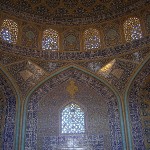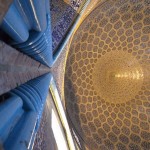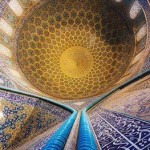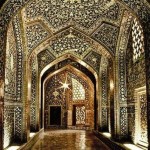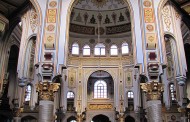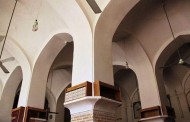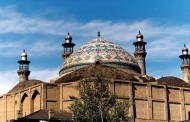Sheikh Lotfollah Mosque is one of the architectural masterpieces of Safavid Iranian architecture, standing on the eastern side of Naghsh-i Jahan Square, Isfahan, Iran.
Construction of the mosque started in 1603 and was finished in 1619. It was built by the chief architect Shaykh Bahai, during the reigh of Shah Abbas I of the Safavid dynasty.
Of the four monuments that dominated the perimeter of the Naqsh-e Jahan Square, this one was the first to be built.
The purpose of this mosque was for it to be a private mosque of the royal court, unlike the Masjed-e Shah, which was meant for the public. For this reason, the mosque does not have any minarets and is of a smaller size. Indeed, few Westerners at the time of the Safavids even paid any attention to this mosque, and they certainly did not have access to it. It wasn’t until centuries later, when the doors were opened to the public, that ordinary people could admire the effort that Shah Abbas had put into making this a sacred place for the ladies of his harem, and the exquisite tile- work, which is far superior to those covering the Shah Mosque.
To avoid having to walk across the maydān when getting to the mosque, Shah Abbas had the architect build a tunnel spanning across the piazza, from the Ali Qapu palace, to the mosque. When reaching the entrance of the mosque, one would have to walk through a passage that winds round and round, until one finally reaches the main building. Along this passage there were standing guards, and the obvious purpose of this design was for the women of the harem to be shielded as much as possible from anyone entering the building. At the main entrance of the mosque there were also standing guards, and the doors of the building were kept closed at all times. Today, these doors are open to visitors, and the passage traversing underneath the field is no longer in use.
The entry gateway, like those of the Grand Bazaar and the Masjed-e Shah, was a recessed half-moon. Also, like in the Masjed-e Shah, the lower facade of the mosque and the gateway are constructed of marble, while the haft-rangi tiles decorate the upper parts of the structure. Creation of the calligraphy and tiles, which exceed, in both beauty and quality, anything created beforehand in the Islamic world, was overseen by Master calligrapher Ali Reza Abbasi.
The monument’s architect was Mohammad-Reza Isfahani, who solved the problem of the difference between the direction of qibla and gateway of the building by devising an L-shaped connecting vestibule between the entrance and the enclosure. Reza Abbasi’s inscription on the entry gateway gives the date of the start of construction. The north-south orientation of the Maydan does not agree with south-west direction of qibla; it is set at 45 degrees to it. This feature, called pāshnah in Persian architecture,has caused to standing the dome not directly behind the entrance iwan
Its single-shell dome is 13 m in diameter. The exterior side is richly covered with tiles.
Compared with the Shah Mosque, the design of the Sheikh Lotf Allah Mosque is quite simple, there is no courtyard and there are no interior iwans. The building itself consists of a flattened dome resting on a square dome chamber. Though, in contranst to the simple structure of this mosque, the decoration of both interior and exterior is exceedingly complex, and in its construction the finest materials were used and the most talented craftsmen employed. Robert Byron wrote about this sight: I know of no finer example of the Persian Islamic genius than the interior of the dome:
The dome is inset with a network of lemon-shaped compartments, which decrease in size as they ascend towards the formalised peacock at the apex… The mihrāb in the west wall is enamelled with tiny flowers on a deep blue meadow. Each part of the design, each plane, each repetition, each separate branch or blossom has its own sombre beauty. But the beauty of the whole comes as you move. Again, the highlights are broken by the play of glazed and unglazed surfaces; so that with every step they rearrange themselves in countless shining patterns… I have never encountered splendour of this kind before.
The “peacock” at the center of the interior side of the dome is one of the unique characteristics of the mosque. If you stand at the entrance gate of the inner hall and look at the center of the dome, a peacock, whose tail is the sunrays coming in from the hole in the ceiling, can be seen.
At the interior side of the dome, the aethetic purpose of the long, low, gloomy passage leading to the dome chamber becomes evident, for it is with a sense of heightened anticipation that one enters the sanctuary. Lowness gives way to soaring height and gloom is dispelled by the steady illumination of nearly a score of windows.
B. Barbara has described it in this way: “the turquoise cable moudling of an arch is seen below the dome, in which concentric rings of thirty-two lozenges diminish in size as they approach a centre which gives an impression of luminosity. The design, which suggests both movement and stillness, is a powerful though not an explicit vehicle of religious symbolism, speaking of the harmony of the universe. … The support system of dome is illustrated by eight great arches of turquoise tilework in cable form which rise from a low dado to the full height of the wall, four in the position of squinches and four against the side walls; between them are kite-shaped squinches-pendentives. Within the dome, ranks of units of tilework of ogee-mandorla form are set in a lattice of plain brick and diminish in size until they meet a central sunbrust patterned with a tracery of arabesque”.
The structure of the dome of Lotfollah mosque and that of Blue mosque of Tabriz is believed to be derived from that of Shah Vali mosque of Taft, Yazd.
The tiling design of this mosque, as well as that of Shah mosque and other Persian mosques of even before Safavid period, seems to be not completely symmetrical – particlularly, in colors of patterns. They have been decribed as intentional, “symmetrical” asymmetries.
Architects of the complex were Sheikh Baha’i (chief architect) and Ustad Mohammad Reza Isfahani.
The building was completed in 1618 (1028 AH).

The interior side of the dome. The decoration seems to lead the eye upwards toward its center, as the rings of ornamental bands filled with arabesque patterns become smaller and smaller.
- Mihrab
- Details of the Interior design of Sheikh Lotf Allah Mosque
- Details of the Interior design of Sheikh Lotf Allah Mosque
- The inscriptions on the dome is written by the famous calligrapher Ali Reza Abbasi, in thuluth and nasta’liq styles.
- Interior of the dome
- Tiles
- Front view – as seen from the balcony of the Ali Qapu palace
- Sheikh Lotf Allah mosque entry gateway








